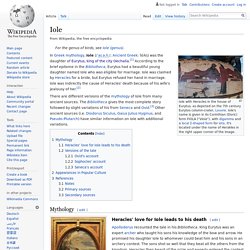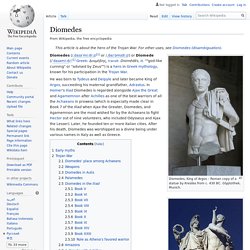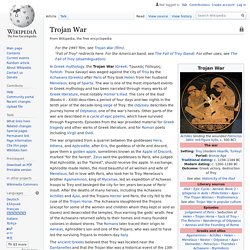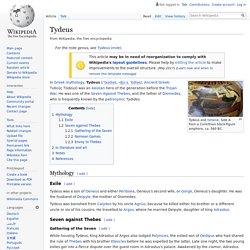

Www.nationalgallery.org. Egeria. Numa Pompilius. King of Rome Numa Pompilius (; 753–673 BC; reigned 715–673 BC) was the legendary second king of Rome,[1] succeeding Romulus.

He was of Sabine origin, and many of Rome's most important religious and political institutions are attributed to him. Genealogy[edit] Titus Livius (Livy) and Plutarch refer to the story that Numa was instructed in philosophy by Pythagoras but discredit it as chronologically and geographically implausible.[3] Kingship[edit] Dryope. In Greek mythology, Dryope (/ˈdraɪ.əpiː/; Ancient Greek: Δρυόπη derived from δρῦς drys, "oak"; dryope "woodpecker"[1]) is the name attributed to several distinct figures: See also[edit] Dryopia References[edit] Jump up ^ Graves, Robert, (1955) 1960.

The Greek Myths.Jump up ^ Virgil, Aeneid, 10. 551Jump up ^ Gaius Valerius Flaccus, Argonautica, 3. 529 ff; Statius, Silvae, 1. 5. 22; 3. 4. 42Jump up ^ Statius, Thebaid, 2. 614 ffJump up ^ Gaius Valerius Flaccus, Argonautica, 2. 174 Sources[edit] External links[edit] Iole. Iole with Heracles in the house of Eurytus, as depicted on the 7th century Eurytos column-crater, Louvre.

Iole's name is given in its Corinthian (Doric) form FIOLA ("Viola"), with digamma and a local Σ-shaped form for iota. It's located under the name of Herakles in the right upper corner of the image. Mythology[edit] King Eurytus of Oechalia. Image of King Eurytus of Oechalia in an Etruscan vase from Caere.

Eurytus is depicted next to Heracles during a symposium. Krater of corinthian columns called 'Krater of Eurytus', circa 600 B.C. Family[edit] Eurytus' grandfather was Apollo, the archer-god, and was also a famed archer. Dīs Pater. 18th century painting showing Mercury (center), Flora (right), and Dīs Pater (left), from Convito per le nozze di Amore e Psiche (The Wedding Feast of Cupid & Psyche), Galleria Nazionale di Palazzo Spinola, Genova It is often thought that Dīs Pater was also a Celtic god.

This confusion arises from the second-hand citation of one of Julius Caesar's comments in his Commentaries on the Gallic Wars (VI:18), where he says that the Gauls all claimed descent from Dīs Pater. Pluto. Dwarf planet in the Kuiper belt of the Solar System Pluto (minor planet designation: 134340 Pluto) is a dwarf planet in the Kuiper belt, a ring of bodies beyond the orbit of Neptune.

It was the first and the largest Kuiper belt object to be discovered. Pluto is the ninth-largest and tenth-most-massive known object directly orbiting the Sun. Diomedes. Hero in Greek mythology Diomedes, King of Argos – Roman copy of a statue by Kresilas from c. 430 BC.

Glyptothek, Munich. Athena counseling Diomedes shortly before he enters the battle. Schlossbrücke, Berlin. Venus. Second planet from the Sun in the Solar System Venus is a terrestrial planet and is sometimes called Earth's "sister planet" because of their similar size, mass, proximity to the Sun, and bulk composition. It is radically different from Earth in other respects. It has the densest atmosphere of the four terrestrial planets, consisting of more than 96% carbon dioxide. The atmospheric pressure at the planet's surface is about 92 times the sea level pressure of Earth, or roughly the pressure at 900 m (3,000 ft) underwater on Earth.
Trojan War. Mythological war Whether there is any historical reality behind the Trojan War remains an open question.

Many scholars believe that there is a historical core to the tale, though this may simply mean that the Homeric stories are a fusion of various tales of sieges and expeditions by Mycenaean Greeks during the Bronze Age. Those who believe that the stories of the Trojan War are derived from a specific historical conflict usually date it to the 12th or 11th century BC, often preferring the dates given by Eratosthenes, 1194–1184 BC, which roughly correspond to archaeological evidence of a catastrophic burning of Troy VII,[4] and the Late Bronze Age collapse.
Sources. Odysseus. Legendary Greek king of Ithaca Odysseus (Greek: Ὀδυσσεύς, Ὀδυσεύς, Ὀdysseús [odysse͜ús]), also known by the Latin variant Ulysses (, ; Latin: Ulyssēs, Ulixēs), is a legendary Greek king of Ithaca and the hero of Homer's epic poem the Odyssey.

Odysseus also plays a key role in Homer's Iliad and other works in that same epic cycle. Son of Laërtes and Anticlea, husband of Penelope, and father of Telemachus and Acusilaus,[1] Odysseus is renowned for his intellectual brilliance, guile, and versatility (polytropos), and is thus known by the epithet Odysseus the Cunning (Greek: μῆτις or mētis, "cunning intelligence"[2]). He is most famous for his nostos, or "homecoming", which took him ten eventful years after the decade-long Trojan War.
Tydeus. Tydeus and Ismene.

Side A from a Corinthian black-figure amphora, ca. 560 BC. In Greek mythology, Tydeus (/ˈtaɪdiəs, -djuːs, ˈtɪdiəs/; Ancient Greek: Τυδεύς Tūdeus) was an Aeolian hero of the generation before the Trojan War. Diomedes of Thrace. Hercules and Diomedes, from a 16th-century original at the Palazzo Vecchio in Florence, Italy; one of six marble statues representing "The Labours of Hercules" by Vincenzo de' Rossi.[1] Mythology[edit] Heracles encounters King Diomedes through performing his eighth labour. Hercules. Roman adaptation of the Greek divine hero Heracles The Romans adapted the Greek hero's iconography and myths for their literature and art under the name Hercules. In later Western art and literature and in popular culture, Hercules is more commonly used than Heracles as the name of the hero.
Hercules was a multifaceted figure with contradictory characteristics, which enabled later artists and writers to pick and choose how to represent him.[1] This article provides an introduction to representations of Hercules in the later tradition. Labours. Mares of Diomedes. Thrace. The Roman province of Thrace. Cyrene. Mars. Diana. Artemis. Deity in ancient Greek religion and myth. Leto. Jupiter. Deucalion. Deianira. Ancient Greek mythical character. Shirt of Nessus. Hercules.
Meleager. Oeneus. Daphne. Apollo. Peneus. Daedalus. Icarus. Daedalion. Ceyx. Cyparissus. Cyllarus. Hylonome. Cygnus. Neptune. Cygnus. Cygnus. Phaethon. Cybele. Phrygia. Miletus. Byblis. Kaunos. Büyük Menderes River. Cyane. Sicily. Syracuse, Sicily. Cupid. Eros. Venus. Mars. Cornix. Minerva. Neptune. Phocis. Clymene. Helios. Heliades. Phaethon.
Circe. Oceanid. Helios. Cipus. Cinyras. Adonis. Cyprus. Adonis. Myrrha. Paphos. Chiron. Centaurus. Lernaean Hydra. Hercules. Ocyrhoe. Saturn. Philyra. Chione. Daedalion. Charybdis. Scylla. Gaia. Neptune. Chariclo. Chiron. Ocyrhoe. Ceyx. Ceyx. Cephalus. Alcyone. Ceres. Demeter. Procris. Aeolus. Cecrops I.